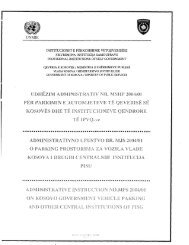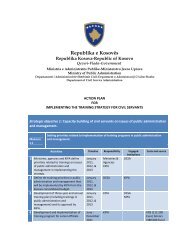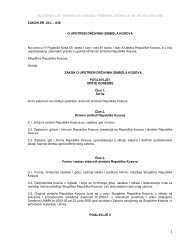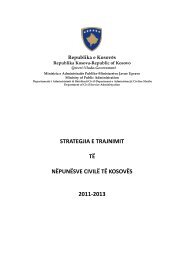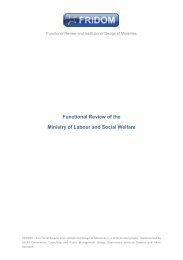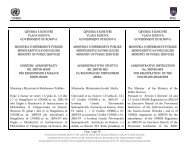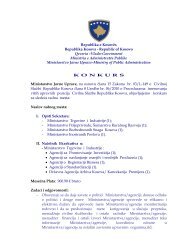Functional Review of the Ministry of Education, Science and ...
Functional Review of the Ministry of Education, Science and ...
Functional Review of the Ministry of Education, Science and ...
Create successful ePaper yourself
Turn your PDF publications into a flip-book with our unique Google optimized e-Paper software.
Based on this analysis, we make 2 recommendations:<br />
Recommendation A.1: Do not reduce staff at <strong>the</strong> MEST. Streng<strong>the</strong>n staff numbers for R&D area<br />
<strong>and</strong> special support area by gradual increase <strong>and</strong> rebalancing <strong>of</strong> <strong>the</strong> HR resources.<br />
Recommendation A.2: Design <strong>and</strong> implement a new MEST’s organizational structure based on 2<br />
levels with <strong>the</strong> following basic rules:<br />
<strong>the</strong> units at <strong>the</strong> upper level are generally called departments, <strong>the</strong> units at <strong>the</strong> lower level are<br />
generally called divisions; o<strong>the</strong>r names can also be used,<br />
each unit at <strong>the</strong> lower level is a part <strong>of</strong> a unit at <strong>the</strong> upper level,<br />
<strong>the</strong>re are no initial limitations on <strong>the</strong> size <strong>and</strong> structure <strong>of</strong> organizational units,<br />
department may or may not be divided into divisions,<br />
<strong>the</strong> partition <strong>of</strong> a department into division need not involve all members <strong>of</strong> <strong>the</strong> department.<br />
Fur<strong>the</strong>r findings <strong>and</strong> recommendations on <strong>the</strong> organizational structure can be found throughout <strong>the</strong> whole<br />
text <strong>of</strong> <strong>the</strong> report.<br />
Human resources<br />
Capacity <strong>of</strong> <strong>the</strong> MEST human resources is <strong>the</strong> most frequently mentioned problem in all assessment<br />
materials on education sector in Kosovo. For example, in <strong>the</strong> above mentioned Swedish study we can find<br />
that “<strong>the</strong> current administration has encountered serious difficulties in managing <strong>the</strong> education sector due<br />
to ...inexperience <strong>of</strong> political <strong>and</strong> civil staff ...” though “it should be recognized that <strong>the</strong>re have been<br />
significant capacity building initiatives (albeit not very systematic) supported by both local institutions <strong>and</strong><br />
international partners, but with limited effect capacity development has mostly been supply-driven <strong>and</strong><br />
largely fragmented <strong>and</strong> has proved to be mostly only marginally effective. Support to capacity<br />
development has to respond more to a clear dem<strong>and</strong> <strong>and</strong> be designed <strong>and</strong> implemented under partner<br />
government leadership. In order to better approach this key area – essential for successful sector-wide<br />
program design <strong>and</strong> implementation – a new approach is needed, including simple <strong>and</strong> effective capacity<br />
needs assessment tools <strong>and</strong> <strong>the</strong> design <strong>of</strong> an overarching capacity development plan.” As can be seen<br />
also from <strong>the</strong>se observations, capacity building activities in education sector have been currently initiated<br />
<strong>and</strong> performed mainly by donors <strong>and</strong> not by <strong>the</strong> MEST. Moreover, <strong>the</strong> effect <strong>of</strong> <strong>the</strong>se activities has been<br />
limited. The MEST’s HR unit has no plan for capacity building. There is a clear need for a strategic<br />
document for capacity building, but this should not delay activities in <strong>the</strong> most urgent areas (basic training<br />
in <strong>the</strong> financial <strong>and</strong> IT issues, information on new regulations <strong>and</strong> organizing courses in languages).<br />
Though with limited effect, some capacity building activities have been recently performed <strong>and</strong> it would be<br />
helpful to have a list <strong>of</strong> <strong>the</strong>se activities <strong>and</strong> <strong>the</strong>ir participants when preparing a new HR capacity building<br />
plan.<br />
Recommendation A.3: Prepare a short-term interim plan for HR development <strong>of</strong> MEST’s employees<br />
in <strong>the</strong> most urgent areas (financial <strong>and</strong> IT literacy, new regulations, languages).<br />
Recommendation A.4: Build a database <strong>of</strong> learning activities that were provided by donors <strong>and</strong><br />
<strong>the</strong>ir participants as well as those activities that are under preparation <strong>and</strong> use it in managing <strong>the</strong><br />
MEST’s capacity building.<br />
Recommendation A.5: Prepare in cooperation with international experts within <strong>the</strong> upcoming<br />
SWAP FOR EDUCATION project a strategic document on HR capacity building. 4 The first step <strong>of</strong> a<br />
comprehensive solution <strong>of</strong> <strong>the</strong> HR capacity building problem is a strategic plan. The roadmap for<br />
<strong>the</strong> preparation <strong>of</strong> such a plan has already been prepared in <strong>the</strong> Swedish study.<br />
4 Developing such a document is recommended also in <strong>the</strong> Report III <strong>of</strong> <strong>the</strong> Swedish study (roadmap 2).<br />
11



